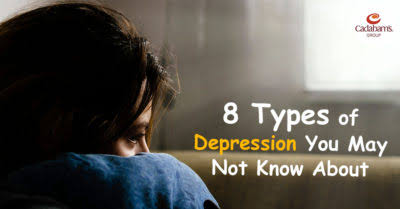Different types of depression.

It may additionally be helpful to know something about these different subtypes, seeing that they often have different symptoms and require different sorts of treatment.
1. Depressive Episode
A single depressive episode is the most common form of depression. It is typically caused through some major life stress, such as the death of a loved one, a divorce, or dropping a job. What begins as stress or grief eventually turns into an episode of major depression, lasting anywhere from a few weeks to a various months. Symptoms include sadness, loss of motivation, hopelessness, fatigue, poor concentration, aches, sleep disturbance, and thoughts of death or suicide. These signs must persist for at least two weeks for a diagnosis of depression. People who get help for an episode of major melancholy typically don’t experience another episode.
2. Recurrent Depression
If you’ve had two or three episodes of major depression, there’s a true chance it might become recurrent. With recurrent depression, and episode may start for no particular reason. Typically, these episodes happen regularly, every 18 months or so. A form of psychotherapy known as mindfulness based cognitive therapy, or MBCT has been shown to be especially effective for humans with recurrent depression.
3. Atypical Depression
There are several features that make atypical depression atypical. First, fantastic events may temporarily lift the depression, whereas with usual depression, things you would normally enjoy are just grey and bland like everything else. Atypical depression also increases your urge for food instead of reducing it, which might lead to weight gain.The other function that distinguishes atypical depression is that it tends to make you sleep a lot, whereas depression typically motives insomnia or waking up in the middle of the night.
4. Dysthymia
Dysthymia is a long lasting, low intensity form of depression. Whereas a everyday depressive episode may last several months, dysthymia lasts two years or more. Although it lasts longer, the symptoms are no longer as intense. Instead of feeling intensely bad for a few weeks or months, people with dysthymia feel pretty terrible for years. In fact, they often forget what it’s like to feel good and expect their mildly depressed mood is normal. There is also a condition called double depression, which is when human beings with dysthymia suffer an episode of major depression. Someone suffering double depression wants treatment for both the depressive episode and the underlying dysthymia.
5. Bipolar Disorder
Bipolar disorder is often unsuitable for unipolar depression. It is misdiagnosed in more than half of cases and it takes an average of 10 years to get the proper diagnosis. People with bipolar disorder experience episodes of major depression and manic or hypomanic episodes, which are characterised by feelings of grandiosity, paranoia, abundant energy, little need for sleep, and reckless behavior. These extreme manic episodes are particularly characteristic of bipolar I, whereas bipolar II typically features milder, hypomanic episodes that may be mistaken for a good mood. Bipolar disorder requires different medicinal drug from unipolar depression. It is typically treated with a combination of an antidepressant and a mood stabilizer.
6. Psychotic Depression
Psychotic melancholy is a severe form of depression that can occur in humans with both unipolar and bipolar depression. People with psychotic depression suffer from delusions and sometimes hallucinations. These delusions have a tendency to be related to intense feelings of worthlessness, exaggerated feelings of guilt, and fears of monetary ruin or disease. These delusions persist in the face of contradictory evidence. Often, people with psychotic depression have to be institutionalized. Because they are out of touch with reality, they are frequently a danger to themselves. Psychotic depression is typically treated with antipsychotic remedy in addition to antidepressants and psychotherapy.
7. Seasonal Affective Disorder
Seasonal affective disorder, or SAD, is a form of major depression triggered by way of a change of seasons. Most people experience SAD in the fall or winter months, likely triggered by lower levels of sunlight. In addition to the everyday symptoms of depression, people with winter SAD often trip the atypical symptoms of excessive sleep and increased appetite. Some human beings also experience summer SAD, which is characterized by way of insomnia, loss of appetite, and anxiety or agitation. Summer SAD seems to be caused by extra sunlight, which disrupts the circadian rhythm. People with bipolar disorder are especially sensitive to disruptions in their circadian rhythms and are therefore greater vulnerable to both summer and winter SAD.
8. Postpartum Depression
Postpartum despair affects about one in seven new mothers. While many women experience the “baby blues” after giving birth, postpartum depression is extra severe, a full episode of major depression. Pregnancy and childbirth cause massive changes in hormones which have an effect on mood and energy. On top of that, giving birth is physically irritating and women have to recovery while sleeping erratically. Having a baby creates new responsibility and financial stress, which may aggravate an already low temper and feeling overwhelmed. These feelings are often compounded by the new mother feeling like she have to be happy about her new baby and guilt that she isn’t. Postpartum depression is one reason despair rates are higher among women. However, new dads can experience postpartum melancholy as well. They are also affected by the stress and lack of sleep caused by a new child and this can develop into depression, especially if they are closely involved with the child’s care.
Nice article po.